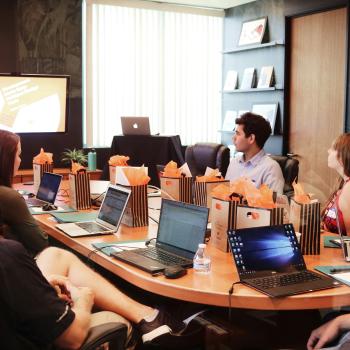
The hybrid work model is an evolving landscape, and insights from different organizations like Luminate, WSP Global, and the Greater Cleveland Food Bank offer a multi-faceted perspective on its implementation and challenges. Through my conversations with Christine Cenicola, Senior Vice President, Head of People at Luminate, Suzanne Puccino, Director Global Workplace Strategy at WSP Global, and Stacey Monroe, Human Resources Director at the Greater Cleveland Food Bank, we can glean a comprehensive understanding of how diverse organizations are adapting to this model.
Flexibility and Adaptation: Key Themes Across Sectors
The concept of flexibility within the hybrid work model emerges as a pivotal theme across various sectors, as seen through the experiences of Luminate, WSP Global, and the Greater Cleveland Food Bank. Each of these organizations, despite their distinct fields and operational goals, has embraced the flexibility inherent in the hybrid model, but they have tailored it to suit their specific needs and challenges.
Luminate, operating in a dynamic corporate environment, emphasizes the balance between in-office collaboration and remote autonomy. This approach is not merely about allowing employees to work from home; it is a strategic decision aimed at fostering a creative and innovative work environment. By enabling employees to work remotely, Luminate provides them with the autonomy to design their work schedules in a way that maximizes their productivity and creativity. Conversely, the designated in-office days focus on harnessing the collaborative spirit, ensuring that the team synergy is not lost in the digital realm. This balance is critical in maintaining a vibrant corporate culture that drives innovation and growth.
WSP Global, with its international footprint, also underscores the importance of this balance but with a nuanced understanding of its impact on operational costs and environmental sustainability. The reduction in occupancy costs, as noted by Puccino, is a direct financial benefit of the hybrid model. Less obvious but equally important is the support for ESG initiatives, which is becoming increasingly vital for businesses worldwide. By reducing the need for physical office space and daily commuting, WSP Global not only cuts down on operational expenses but also contributes to broader environmental goals, aligning its business strategy with global sustainability efforts.
The Greater Cleveland Food Bank presents a unique perspective, as shared by Stacey Monroe. Their mission-centric approach to hybrid work underscores the adaptability of their workforce. Operating in the non-profit sector with a focus on community service, the Food Bank’s adoption of hybrid work arrangements is driven by the need to balance mission fulfillment with employee well-being. Monroe highlights how the pandemic-induced shift to remote work was smoothly integrated into their existing flexible work policies, reflecting the Food Bank’s long-standing commitment to adaptability and employee support. This approach allows them to continue serving the community effectively while also respecting the personal and professional needs of their staff.
Challenges and Innovative Solutions
The hybrid work model, while beneficial, is not without its unique set of challenges. Each organization has faced distinct hurdles in their journey toward a successful hybrid work environment. These challenges, however, have spurred innovative solutions that demonstrate the resilience and adaptability of these organizations.
Luminate, operating in a fast-paced, project-driven environment, faced the challenge of aligning individual employee needs with overarching team and organizational objectives. This challenge is particularly pronounced in a hybrid setup where team members are not always physically present. To address this, Luminate has implemented a series of strategies to ensure that even when working remotely, employees remain aligned with the company’s goals. Regular virtual check-ins, clear and measurable objectives, and robust project management tools have been key in maintaining this alignment. Additionally, Luminate has fostered a culture where feedback is continuous and not just limited to formal reviews, helping to keep individual and team goals in sync.
WSP Global, with its widely-distributed workforce and varied departmental structures, contends with the challenge of maintaining strong manager-employee connections in a hybrid setting. To bridge the physical distance, WSP has leveraged technology to its advantage, using collaboration tools and platforms that facilitate regular and effective communication. They have also placed an emphasis on training managers in the nuances of remote leadership, ensuring they have the skills and tools needed to effectively connect with and support their team members, irrespective of their physical location. This focus on developing managerial competencies in remote team management has been crucial in maintaining team cohesion and employee engagement.
The Greater Cleveland Food Bank, with its mission-centric operations, grapples with integrating flexible schedules into their work without compromising their service delivery. Monroe highlights the organization’s innovative approach to communication and team building. Recognizing the importance of regular, clear communication, the Food Bank has employed a variety of communication tools to keep staff informed and engaged. This includes not only digital communication platforms but also mandatory quarterly in-person meetings. These meetings serve not only as an information-sharing forum but also as a team-building exercise, ensuring that employees, whether they work remotely or on-site, feel a part of the cohesive unit. Additionally, the introduction of social events like “First Fridays” provides a casual setting for team members to connect and interact, further fostering a sense of community and belonging.
Internal Strategies and External Collaborations
In navigating the complexities of the hybrid work model, Luminate, WSP Global, and the Greater Cleveland Food Bank have demonstrated a strategic blend of internal initiatives and selective external collaborations. This approach underscores their commitment to addressing the unique challenges of hybrid work while leveraging external expertise where necessary.
WSP Global’s approach illustrates a strategic use of external resources to complement their internal efforts. Understanding the vastness and diversity of their global operations, WSP Global acknowledges that external consultancy can offer valuable expertise in areas such as remote workforce management, technology integration, and cross-cultural team building. This external support is not seen as a replacement for internal strategies but rather as an enhancement, providing additional resources and perspectives that can be integrated into the company’s existing framework. This selective use of external support helps WSP Global stay at the forefront of best practices in hybrid work models while maintaining a strong foundation of internal policies and practices.
The Greater Cleveland Food Bank, as articulated by Monroe, showcases a robust internal framework designed to support their hybrid work model. Their internal communication systems are a testament to their dedication to keeping all staff, regardless of their work location, in the loop and engaged. This is critical in an organization where the work is mission-driven and requires a high level of coordination and collaboration. Moreover, their structured onboarding programs are particularly noteworthy. These programs are designed not just to introduce new employees to the organization but to integrate them fully into its culture and operations, ensuring they can contribute effectively, whether they are in the office or working remotely. This internal focus on effective communication and comprehensive onboarding plays a crucial role in maintaining a cohesive and efficient workforce.
Luminate’s approach to the hybrid work challenge focuses on internal problem-solving, backed by a culture that promotes innovation and agility. Their strategies are largely centered on creating an environment where employees can thrive both in and out of the office. This includes developing internal policies that support flexible working while ensuring productivity and engagement. However, Luminate also recognizes the value of external insights, particularly in areas like technology adoption and management training, where outside expertise can provide a fresh perspective or specialized knowledge. This balance between internal solutions and external insights allows Luminate to remain adaptable and forward-thinking in their approach to hybrid work.
Having served as an external expert providing management training in hybrid work for over two dozen companies, I’ve seen many leaders go into such training sessions skeptical of hybrid models. They don’t feel like they can have true oversight of their team in a hybrid setting, and lack confidence that their team members are doing their work; they don’t know how to facilitate effective collaboration, innovation, and creativity in hybrid contexts; and they feel concerned about how to coach and mentor junior staff. All of these and more represent key components of successful hybrid management training.
Future Outlook: Balancing Organizational Goals with Employee Needs
As we peer into the future of hybrid work, the experiences of Luminate, WSP Global, and the Greater Cleveland Food Bank provide a blueprint for striking a crucial balance between organizational goals and employee well-being. This balance is not static but a dynamic equilibrium, responsive to the changing needs of both the organization and its workforce.
The Greater Cleveland Food Bank, under Monroe’s guidance, exemplifies this adaptive approach. As the organization grows and its mission expands, they continuously evaluate and modify their hybrid work policies to ensure they align with their service objectives and the needs of their staff. This evolution reflects a deep understanding of the importance of flexibility in a mission-driven environment, where the demands of service delivery must be balanced with the well-being of those delivering that service.
Luminate, with its focus on community building and innovation, is navigating a similar path. They recognize that the future of work lies in creating an environment where employees feel connected and valued, irrespective of their physical work location. This approach is pivotal in ensuring that team collaboration and company culture thrive in a hybrid setting. It involves continuously assessing and adjusting policies to ensure that they foster a sense of belonging and support the overall objectives of the organization.
WSP Global, with its global presence and commitment to ESG initiatives, is also charting a course for the future that acknowledges the importance of sustainability and cost-effectiveness. Their approach to hybrid work is not just about improving the bottom line; it’s also about creating a work environment that is sustainable and responsive to the needs of a diverse global workforce. This perspective is crucial in ensuring that the organization remains competitive and responsible in an increasingly interconnected world.
Conclusion
The diverse experiences of these three organizations underscore the fact that there is no one-size-fits-all approach to hybrid work. Each organization’s strategy is informed by its unique goals, culture, and workforce needs. Luminate’s emphasis on community and collaboration, WSP Global’s focus on sustainability and cost-effectiveness, and the Greater Cleveland Food Bank’s commitment to adaptability and service, all demonstrate different facets of how hybrid work can be successfully implemented and managed. These case studies also highlight the importance of continuous learning and adaptation. The future of hybrid work will likely involve ongoing adjustments as organizations learn more about what works and what doesn’t in their specific contexts. It will require a willingness to experiment, to listen to employee feedback, and to be agile in response to changing circumstances.
Key Take-Away
The evolving landscape of the Hybrid Work Model reveals that flexibility and adaptation are crucial across various sectors. Insights from organizations like Luminate, WSP Global, and the Greater Cleveland Food Bank demonstrate diverse approaches in balancing remote autonomy with in-office collaboration, emphasizing employee well-being and operational efficiency…>Click to tweet
Image credit: Vitaly Gariev/Pexels
Originally published in Disaster Avoidance Experts
Dr. Gleb Tsipursky was lauded as “Office Whisperer” and “Hybrid Expert” by The New York Times for helping leaders use hybrid work to improve retention and productivity while cutting costs. He serves as the CEO of the boutique future-of-work consultancy Disaster Avoidance Experts. Dr. Gleb wrote the first book on returning to the office and leading hybrid teams after the pandemic, his best-seller Returning to the Office and Leading Hybrid and Remote Teams: A Manual on Benchmarking to Best Practices for Competitive Advantage (Intentional Insights, 2021). He authored seven books in total, and is best know for his global bestseller, Never Go With Your Gut: How Pioneering Leaders Make the Best Decisions and Avoid Business Disasters (Career Press, 2019). His cutting-edge thought leadership was featured in over 650 articles and 550 interviews in Harvard Business Review, Forbes, Inc. Magazine, USA Today, CBS News, Fox News, Time, Business Insider, Fortune, and elsewhere. His writing was translated into Chinese, Korean, German, Russian, Polish, Spanish, French, and other languages. His expertise comes from over 20 years of consulting, coaching, and speaking and training for Fortune 500 companies from Aflac to Xerox. It also comes from over 15 years in academia as a behavioral scientist, with 8 years as a lecturer at UNC-Chapel Hill and 7 years as a professor at Ohio State. A proud Ukrainian American, Dr. Gleb lives in Columbus, Ohio. In his free time, he makes sure to spend abundant quality time with his wife to avoid his personal life turning into a disaster. Contact him at Gleb[at]DisasterAvoidanceExperts[dot]com, follow him on LinkedIn @dr-gleb-tsipursky, Twitter @gleb_tsipursky, Instagram @dr_gleb_tsipursky, Facebook @DrGlebTsipursky, Medium @dr_gleb_tsipursky, YouTube, and RSS, and get a free copy of the Assessment on Dangerous Judgment Errors in the Workplace by signing up for the free Wise Decision Maker Course at https://disasteravoidanceexperts.com/newsletter/.


















